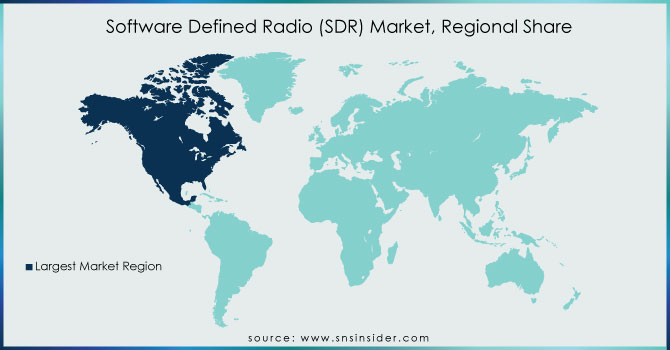Software Defined Radio (SDR) Market Report Scope & Overview:

To get more information on Software Defined Radio (SDR) Market - Request Free Sample Report
The Software Defined Radio (SDR) Market Size was valued at USD 13.72 billion in 2023 and is expected to reach USD 21.65 billion by 2032 with an emerging CAGR of 5.2% over the forecast period 2024-2032.
A rise in defense spending to improve defense communication systems is driving the demand for Software Defined Radio systems. The worldwide Software Defined Radio sector has risen dramatically as a result of the increased demand for communication equipment that is more flexible and software programmable. Furthermore, SDR is widely utilized in space communication because it improves satellite performance and enables precise operation across a wide range of frequency bands. SDR enables users to receive signals from many mobile protocols, such as WiMAX and GSM. Mobile carriers are using SDRs to fulfil the increasing demand for greater data speeds, which entails more hardware expenses on the core network. Furthermore, significant development in the telecommunications industry/market is expected to boost market growth.
Furthermore, numerous advances, including as the creation of next-generation internet protocol systems that can be adapted to 4G and wireless spectrums, are contributing to the market's upbeat outlook. Furthermore, SDR is increasingly being applied in the 3.5 GHz and 25 GHz spectrum bands for 5G mobile network testing, which is projected to create a profitable opportunity for industry participants. Another driver of growth is the quick transition from analogue to digital SDR. SDR is designed to be the basic technology for transmitting telecommunications services such as digital television, radio broadcasts, and video streaming channels. Other factors, such as the integration of the Internet of Things with wireless devices, as well as active R&D in the telecommunications sector, are likely to boost the market even further. The majority of its functionality is implemented in the radio system by software running on an embedded device or a personal computer. As a result, there will always be the possibility of software attacks. This issue is predicted to stymie market growth during the forecast period. Furthermore, for a simple work, basic SDR tends to need more power. As a result, it can only be used in extremely low-power devices.
MARKET DYNAMICS
KEY DRIVERS
-
Growing demand
-
Technology advancement
RESTRAINTS
-
Cyber threats
-
Software installation issues
OPPORTUNITIES
-
Enhanced IP-Radio system demand
CHALLENGES
-
Interoperability of several communication technologies
IMPACT OF COVID-19
The COVID 19 epidemic is spreading like wildfire and has had a profound effect on the economic activity of various growing industries in various parts of the world. The SDR system, as well as subsystem management was severely affected and disrupted due to the spread of the epidemic. However, the production of SDRs to meet the requirements of the military application is very important and steps are being taken to reduce disruption to the same supply chain management. Restarting the production and production process depends largely on the manifestation of the epidemic, the level of production of production units, the tolerance of restrictions, and, the import and export permit by government regulations. However, production and production units are active and take orders regardless of the adjustment of operating schedules. According to industry experts, the defense sector is increasing its focus on sectors that play an important role in securing national interests. The supply chain market has a moderate impact. However, measures to deal with the current situation are being taken to control the market demand in the balance by providing delivery funds before the specified period.
The software defined radio market is divided into four platforms: land, airborne, naval, and space. During the predicted period, the land segment is expected to rises at the fastest CAGR. The usage of software-defined radios in military and commercial applications is covered in the land platform category. The land section covers both fixed and mobile unit installation. The increasing need for SDRs used in military vehicles and cellular sites is projected to promote land sector growth in the coming years. The US Joint Tactical Radio System programme produced one of the military software defined radios for ground platforms. The software defined radio market has been divided into components such as general-purpose processors, digital signal processors, field programmable gate arrays, application-specific integrated circuits, amplifiers, converters, software, and others. Because of the increasing use of software to boost interoperability of software defined radio systems with new communication standards, the software segment is predicted to develop at a faster CAGR. Software defined radios offer the advantage of being upgradeable, which lowers their replacement costs. They are easily upgraded to accommodate new communication standards by downloading new system files with the software included with their operating systems. The enhancements allow software defined radios to adapt to new communication protocols and military waveforms.
The technology is generally recognized in the defense industry since it includes multi-mode/multi-band pre-emptive radio sets that allow for speech and data transmission in warfighter. Based on Software Communications Architecture 4.0, open-source programming forms an integral part of JTRS. JTRS program of the U.S Department of Defense it also promotes the growth of the JTRS component.
Terrestrial Trunked Radio is an open digital radio platform in the international market. Contains high performance for emergency services and is suitable for large commercial radio users. TETRA specifies specific areas of interaction such as a virtual interface, terminal equipment, direct mode operation, and in-app virtual interface to work effectively in the multivendor market. TETRA is the largest mobile radio standard that provides spectrum efficiency and critical communication features such as short call setup time, security, high-speed data resources, and voice-enabled voice feature and site reduction.
KEY MARKET SEGMENTATION
By Frequency Band
-
HF
-
VHF
-
UHF
By Application
-
Defense
-
Commercial
By Type
-
General Purpose Radios
-
Cognitive/Intelligent Radio
-
Terrestrial Trunked Radio
By Platform
-
Land
-
Airborne
-
Naval
-
Space
By Component
-
Transmitter
-
Receiver
-
Software
-
Auxiliary System
REGIONAL ANALYSIS
The North American market is expected to have the largest SDR market. precisely, the American market is expected to take the market to growing areas. The US region has emerged as a pioneer in the development of SDRs. These systems may support the operation of advanced radios. Many American companies have been contracted by the US military to develop radio programs that will be used on social media. These contracts are likely to be made for 5 years or more and include development, as well as production. Also, companies are committed to supporting up to 5000 radio stations in total. Apart from this, the software component operating in other major areas such as the APAC region is expected to achieve higher CAGR growth. The reason for this is an increase in software implementation that will increase the power of these programs to establish a better way of communication standards.

Need any customization research on Software Defined Radio (SDR) Market - Enquiry Now
REGIONAL COVERAGE:
-
North America
-
USA
-
Canada
-
Mexico
-
-
Europe
-
Germany
-
UK
-
France
-
Italy
-
Spain
-
The Netherlands
-
Rest of Europe
-
-
Asia-Pacific
-
Japan
-
south Korea
-
China
-
India
-
Australia
-
Rest of Asia-Pacific
-
-
The Middle East & Africa
-
Israel
-
UAE
-
South Africa
-
Rest of Middle East & Africa
-
-
Latin America
-
Brazil
-
Argentina
-
Rest of Latin America
-
KEY PLAYERS
The Major Players are General Dynamics Corporation, Raytheon Technologies Corporation, Northrop Grumman Corporation, Thales, Leonardo Company, BAE Systems, L3Harris Technologies, Inc, Elbit Systems Ltd., and other players
| Report Attributes | Details |
|---|---|
| Market Size in 2023 | US$ 13.72 Billion |
| Market Size by 2032 | US$ 21.65 Billion |
| CAGR | CAGR of 5.2% From 2024 to 2032 |
| Base Year | 2023 |
| Forecast Period | 2024-2032 |
| Historical Data | 2020-2022 |
| Report Scope & Coverage | Market Size, Segments Analysis, Competitive Landscape, Regional Analysis, DROC & SWOT Analysis, Forecast Outlook |
| Key Segments | • By Frequency Band (HF, VHF, UHF) • By Application (Defense, Commercial) • By Type (General Purpose Radios, Cognitive/Intelligent Radio, Terrestrial Trunked Radio) • By Platform (Land, Airborne, Naval, Space) • By Component (Transmitter, Receiver, Software, Auxiliary System) |
| Regional Analysis/Coverage | North America (USA, Canada, Mexico), Europe (Germany, UK, France, Italy, Spain, Netherlands, Rest of Europe), Asia-Pacific (Japan, South Korea, China, India, Australia, Rest of Asia-Pacific), The Middle East & Africa (Israel, UAE, South Africa, Rest of Middle East & Africa), Latin America (Brazil, Argentina, Rest of Latin America) |
| Company Profiles | General Dynamics Corporation, Raytheon Technologies Corporation, Northrop Grumman Corporation, Thales, Leonardo Company, BAE Systems, L3Harris Technologies, Inc, Elbit Systems Ltd., and other players. |
| DRIVERS | • Growing demand • Technology advancement |
| RESTRAINTS | • Cyber threats • Software installation issues |

